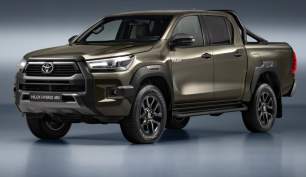The strong whiff of leather is a nice way to start each journey. The full-length side steps and grab handles are required for every climb in and out of the elevated cabin which provides a commanding view of the world, even though the outer edges of its vast bonnet and front mudguards disappear from view.
The front seats are wide and comfortable with good lateral support and rear seat passengers have generous head, shoulder and legroom as you would expect. Although it feels huge when you first climb aboard, the RAM starts to shrink around you the more you drive it, aided by front and rear parking sensors and a reversing camera for tight parking situations (which is most of the time).
Its height of 1974mm (Ranger 1848mm) will still clear most undercover car parks (usually 2100mm limit) and its 2009mm width is only 150mm wider than a Ranger, so it will also fit within most car parking spaces. The biggest parking handicap is its oil tanker-like 6030mm length which is 675mm longer than the Ranger, so you need plenty of room for reversing.
On the highway it has a remarkably quiet cabin environment thanks to substantial ASV-added sound insulation, low wind noise and minimal tyre roar.
Ride quality when empty is generally good, although you do notice the firmness of the heavy duty spring rates over larger bumps. Acceleration is spirited, too, with an unbridled 1084Nm shoving you in the back and the steering is nicely weighted and relatively direct for an old-school steering box set-up.
The quartet of disc brakes, though, do not have the bite relative to pedal effort one might expect. ASV engineers claim it's the result of pad compounds which have to withstand the heat of up to 7.0 tonne towing loads, so they tend to be relatively hard.
On the highway it has a remarkably quiet cabin environment thanks to substantial ASV-added sound insulation, low wind noise and minimal tyre roar. At 100km/h with no payload, the 6.7 litre Cummins barely ticked over at 1400rpm and that hardly changed when we hooked up a dual axle New Age Caravan with a 3270kg tare weight.
Given that was less than half of its peak towing capacity, the big RAM barely noticed it was there. The engine's massive 1084Nm of torque at only 1600rpm was most impressive on long gradual climbs, allowing the truck and caravan combo to squash each hill in top gear with minimal throttle.
Each time you ease off the accelerator, too, the exhaust brake provides more than enough retardation (and Kenworth sound effects) to ensure you rarely need to push the brake pedal. And when you do, the electric trailer brake control provides powerful and sure-footed stopping power. The door mirrors were also wide enough to see along each side of the van and approaching rear traffic.






